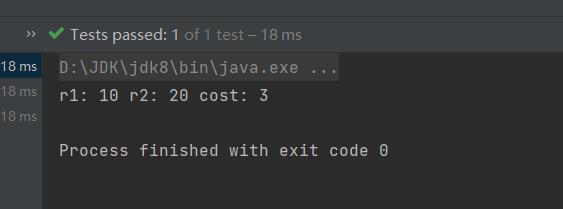并发编程之java线程
Posted _瞳孔
tags:
篇首语:本文由小常识网(cha138.com)小编为大家整理,主要介绍了并发编程之java线程相关的知识,希望对你有一定的参考价值。
一:创建线程
方法一:
@Slf4j
public class demo1
public static void main(String[] args)
Thread t = new Thread("t1")
@Override
public void run()
// 要执行的任务
log.debug("hello");
;
// 启动线程
t.start();
log.debug("run");
方法二:Runnable类可以作为Thread构造函数的参数传入

@Slf4j
public class demo2
public static void main(String[] args)
Runnable r = new Runnable()
@Override
public void run()
// 要执行的任务
log.debug("hello");
;
// 创建线程对象
Thread t = new Thread(r, "t2");
// 启动线程
t.start();
方法二的lambda简化
@Slf4j
public class demo3
public static void main(String[] args)
Runnable r = () -> log.debug("hello"); ;
Thread t = new Thread(r, "t2");
t.start();
方法三:使用FutureTask类,FutureTask实现了Runnable接口,因此也可以传入Thread(Runnable target, String name)

@Slf4j
public class demo4
public static void main(String[] args) throws Exception
FutureTask<Integer> task3 = new FutureTask<>(new Callable<Integer>()
@Override
public Integer call() throws Exception
log.debug("running");
Thread.sleep(1000);
return 100;
);
new Thread(task3, "t3").start();
// 主线程调用get方法时,主线程会等待t3线程返回值
log.debug("结果是:", task3.get());
log.debug("hello");
二:线程运行原理
栈与栈帧:Java Virtual Machine Stacks (Java 虚拟机栈)
JVM 中由堆、栈、方法区所组成,其中栈内存其实就是给线程用的,每个线程启动后,虚拟
机就会为其分配一块栈内存。
- 每个栈由多个栈帧(Frame)组成,对应着每次方法调用时所占用的内存
- 每个线程只能有一个活动栈帧,对应着当前正在执行的那个方法
线程上下文切换:Thread Context Switch
因为以下一些原因导致 cpu 不再执行当前的线程,转而执行另一个线程的代码
- 线程的 cpu 时间片用完
- 垃圾回收
- 有更高优先级的线程需要运行
- 线程自己调用了 sleep、yield、wait、join、park、synchronized、lock 等方法
当 Context Switch 发生时,需要由操作系统保存当前线程的状态,并恢复另一个线程的状态,Java 中对应的概念就是程序计数器(Program Counter Register),它的作用是记住下一条 jvm 指令的执行地址,是线程私有的
- 状态包括程序计数器、虚拟机栈中每个栈帧的信息,如局部变量、操作数栈、返回地址等
- Context Switch 频繁发生会影响性能
三:常见方法
| 方法名 | static | 功能说明 | 注意 |
|---|---|---|---|
| start() | 启动一个新线程,在新的线程运行 run 方法中的代码 | start 方法只是让线程进入就绪,里面代码不一定立刻运行(CPU 的时间片还没分给它)。每个线程对象的start方法只能调用一次,如果调用了多次会出现IllegalThreadStateException | |
| run() | 新线程启动后会调用的方法 | 如果在构造 Thread 对象时传递了 Runnable 参数,则线程启动后会调用 Runnable 中的 run 方法,否则默认不执行任何操作。但可以创建 Thread 的子类对象,来覆盖默认行为 | |
| join() | 等待线程运行结束 | ||
| join(long n) | 等待线程运行结束,最多等待 n毫秒 | ||
| getId() | 获取线程长整型的 id | id 唯一 | |
| getName() | 获取线程名 | ||
| setName(String) | 修改线程名 | ||
| getPriority() | 获取线程优先级 | ||
| setPriority(int) | 修改线程优先级 | java中规定线程优先级是1~10 的整数,较大的优先级能提高该线程被 CPU 调度的机率 | |
| getState() | 获取线程状态 | Java 中线程状态是用 6 个 enum 表示,分别为:NEW, RUNNABLE, BLOCKED, WAITING, TIMED_WAITING, TERMINATED | |
| isInterrupted() | 判断是否被打断 | 不会清除 打断标记 | |
| isAlive() | 线程是否存活(还没有运行完毕) | ||
| interrupt() | 打断线程 | 如果被打断线程正在 sleep,wait,join 会导致被打断的线程抛出 InterruptedException,并清除 打断标记 ;如果打断的正在运行的线程,则会设置 打断标记 ;park 的线程被打断,也会设置 打断标记 | |
| interrupted() | static | 判断当前线程是否被打断 | 会清除 打断标记 |
| currentThread() | static | 获取当前正在执行的线程 | |
| sleep(long n) | static | 让当前执行的线程休眠n毫秒,休眠时让出 cpu的时间片给其它线程 | |
| yield() | static | 提示线程调度器让出当前线程对CPU的使用 | 主要是为了测试和调试 |
1). start 与 run
public static void main(String[] args)
Thread t1 = new Thread("t1")
@Override
public void run()
log.debug(Thread.currentThread().getName());
FileReader.read(Constants.MP4_FULL_PATH); // 读取文件,耗时较长
;
t1.run();
log.debug("do other things ...");
输出:
19:39:14 [main] c.TestStart - main
19:39:14 [main] c.FileReader - read [1.mp4] start ...
19:39:18 [main] c.FileReader - read [1.mp4] end ... cost: 4227 ms
19:39:18 [main] c.TestStart - do other things ...
可见程序仍在 main 线程运行, FileReader.read() 方法调用还是同步的
public static void main(String[] args)
Thread t1 = new Thread("t1")
@Override
public void run()
log.debug(Thread.currentThread().getName());
FileReader.read(Constants.MP4_FULL_PATH); // 读取文件,耗时较长
;
t1.start();
log.debug("do other things ...");
输出:
19:41:30 [main] c.TestStart - do other things ...
19:41:30 [t1] c.TestStart - t1
19:41:30 [t1] c.FileReader - read [1.mp4] start ...
19:41:35 [t1] c.FileReader - read [1.mp4] end ... cost: 4542 ms
程序在 t1 线程运行, FileReader.read() 方法调用是异步的
因此可以得出:
- 直接调用 run 是在主线程中执行了 run,没有启动新的线程
- 使用 start 是启动新的线程,通过新的线程间接执行 run 中的代码
2). sleep 与 yield
sleep
- 调用 sleep 会让当前线程从运行状态进入 Timed Waiting 状态(阻塞)
- 其它线程可以使用 interrupt 方法打断正在睡眠的线程,这时 sleep 方法会抛出 InterruptedException
- 睡眠结束后的线程未必会立刻得到执行
- 建议用 TimeUnit 的 sleep 代替 Thread 的 sleep 来获得更好的可读性
yield
- 调用 yield 会让当前线程从 Running 进入 Runnable 就绪状态,然后调度执行其它线程
- 具体的实现依赖于操作系统的任务调度器
@Test
public void test5()
Runnable task1 = () ->
int count = 0;
for (;;)
System.out.println("---->1 " + count++);
;
Runnable task2 = () ->
int count = 0;
for (;;)
Thread.yield();
System.out.println(" ---->2 " + count++);
;
Thread t1 = new Thread(task1, "t1");
Thread t2 = new Thread(task2, "t2");
t1.start();
t2.start();

3).线程优先级
- 线程优先级会提示(hint)调度器优先调度该线程,但它仅仅是一个提示,调度器可以忽略它
- 如果 cpu 比较忙,那么优先级高的线程会获得更多的时间片,但 cpu 闲时,优先级几乎没作用

从源码可以看出,最小优先级是1,最大优先级是10
@Test
public void test5()
Runnable task1 = () ->
int count = 0;
for (;;)
System.out.println("---->1 " + count++);
;
Runnable task2 = () ->
int count = 0;
for (;;)
System.out.println(" ---->2 " + count++);
;
Thread t1 = new Thread(task1, "t1");
Thread t2 = new Thread(task2, "t2");
t1.setPriority(Thread.MIN_PRIORITY); // 最高优先级
t2.setPriority(Thread.MAX_PRIORITY); // 最低优先级
t1.start();
t2.start();

可见高优先级的线程执行时间更多。
4). join
static int r = 0;
@Test
public void test7()
System.out.println("开始");
Thread t1 = new Thread(() ->
System.out.println("开始");
try
Thread.sleep(1000);
catch (InterruptedException e)
e.printStackTrace();
System.out.println("结束");
r = 10;
);
t1.start();
System.out.println("结果为: " + r);
System.out.println("结束");

那么如果现在有一个需求,就是主线程要获得子线程执行结束后的r的值,那么就需要主线程等子线程执行完,这时候就可以使用join方法:


static int r1 = 0;
static int r2 = 0;
@Test
public void test8() throws InterruptedException
Thread t1 = new Thread(() ->
try
Thread.sleep(1);
catch (InterruptedException e)
e.printStackTrace();
r1 = 10;
);
Thread t2 = new Thread(() ->
try
Thread.sleep(2);
catch (InterruptedException e)
e.printStackTrace();
r2 = 20;
);
long start = System.currentTimeMillis();
t1.start();
t2.start();
t1.join();
t2.join();
long end = System.currentTimeMillis();
System.out.println("r1: " + r1 + " r2: " + r2 + " cost: " + (end - start));
很明显结果是这样的:

那如果t1和t2的join顺序调换,那么结果会是一模一样的,原因如下图:

5). interrupt
package com.eyes.thread.thread.method;
import org.junit.jupiter.api.Test;
import java.util.concurrent.locks.LockSupport;
public class Method
/**
* interrupt打断阻塞线程
*/
@Test
public void test() throws InterruptedException
Thread t = new Thread(() ->
System.out.println("sleep....");
try
Thread.sleep(5000);
catch (InterruptedException e)
e.printStackTrace();
;
);
t.start();
Thread.sleep(1000);
System.out.println("interrupt");
t.interrupt();
System.out.println("打断标记: " + t.isInterrupted());
/**
* interrupt打断正常运行线程
*/
@Test
public void test2() throws InterruptedException
Thread t = new Thread(() ->
while(true)
Boolean interrupted = Thread.currentThread().isInterrupted();
if(interrupted)
System.out.println("被打断了,推出循环");
break;
);
t.start();
Thread.sleep(1000);
System.out.println("interrupt");
t.interrupt();
/**
* park方法
*/
@Test
public void test3() throws InterruptedException
Thread thread = new Thread(() ->
System.out.println("start.....");
try
Thread.sleep(1000);
catch (InterruptedException e)
e.printStackTrace();
System.out.println("park....");
LockSupport.park();
System.out.println("resume.....");
);
thread.start();
Thread.sleep(2000);
System.out.println("unpark....");
LockSupport.unpark(thread);
/**
* interrupt打断park
*/
@Test
public void test4() throws InterruptedException
Thread t = new Thread(() ->
System.out.println("park...");
LockSupport.park();
System.out.println("unpark...");
System.out.println("打断状态: " + Thread.currentThread().interrupted());
LockSupport.park();
System.out.println("again...");
);
t.start();
t.sleep(1000);
t.interrupt();
/**
* 设计模式之两阶段终止
*/
class TwoPhaseTermination
private Thread monitor;
// 启动监控线程
public void start()
monitor = new Thread(